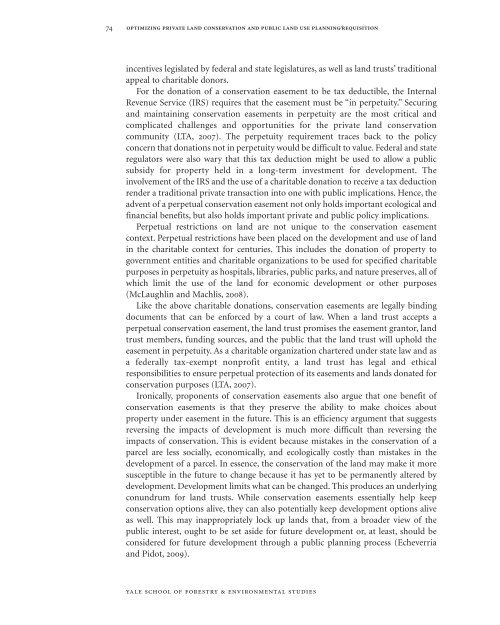Complete Report - Yale University
Complete Report - Yale University
Complete Report - Yale University
You also want an ePaper? Increase the reach of your titles
YUMPU automatically turns print PDFs into web optimized ePapers that Google loves.
74OPTIMIZING PRIVATE LAND CONSERVATION AND PUBLIC LAND USE PLANNING⁄REQUISITIONincentives legislated by federal and state legislatures, as well as land trusts’ traditionalappeal to charitable donors.For the donation of a conservation easement to be tax deductible, the InternalRevenue Service (IRS) requires that the easement must be “in perpetuity.” Securingand maintaining conservation easements in perpetuity are the most critical andcomplicated challenges and opportunities for the private land conservationcommunity (LTA, 2007). The perpetuity requirement traces back to the policyconcern that donations not in perpetuity would be difficult to value. Federal and stateregulators were also wary that this tax deduction might be used to allow a publicsubsidy for property held in a long-term investment for development. Theinvolvement of the IRS and the use of a charitable donation to receive a tax deductionrender a traditional private transaction into one with public implications. Hence, theadvent of a perpetual conservation easement not only holds important ecological andfinancial benefits, but also holds important private and public policy implications.Perpetual restrictions on land are not unique to the conservation easementcontext. Perpetual restrictions have been placed on the development and use of landin the charitable context for centuries. This includes the donation of property togovernment entities and charitable organizations to be used for specified charitablepurposes in perpetuity as hospitals, libraries, public parks, and nature preserves, all ofwhich limit the use of the land for economic development or other purposes(McLaughlin and Machlis, 2008).Like the above charitable donations, conservation easements are legally bindingdocuments that can be enforced by a court of law. When a land trust accepts aperpetual conservation easement, the land trust promises the easement grantor, landtrust members, funding sources, and the public that the land trust will uphold theeasement in perpetuity. As a charitable organization chartered under state law and asa federally tax-exempt nonprofit entity, a land trust has legal and ethicalresponsibilities to ensure perpetual protection of its easements and lands donated forconservation purposes (LTA, 2007).Ironically, proponents of conservation easements also argue that one benefit ofconservation easements is that they preserve the ability to make choices aboutproperty under easement in the future. This is an efficiency argument that suggestsreversing the impacts of development is much more difficult than reversing theimpacts of conservation. This is evident because mistakes in the conservation of aparcel are less socially, economically, and ecologically costly than mistakes in thedevelopment of a parcel. In essence, the conservation of the land may make it moresusceptible in the future to change because it has yet to be permanently altered bydevelopment. Development limits what can be changed. This produces an underlyingconundrum for land trusts. While conservation easements essentially help keepconservation options alive, they can also potentially keep development options aliveas well. This may inappropriately lock up lands that, from a broader view of thepublic interest, ought to be set aside for future development or, at least, should beconsidered for future development through a public planning process (Echeverriaand Pidot, 2009).yale school of forestry & environmental studies
















